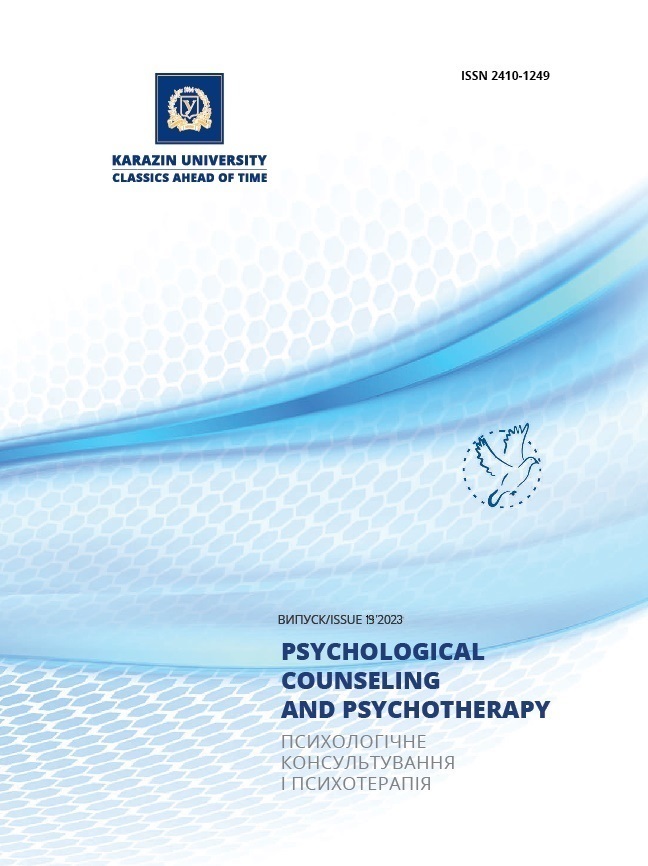The technique of schematic visualization of the emotional sphere in group psychotherapy work with clients who have a low level of reflexivity
Abstract
The article aims to describe the technique of schematic visualization of the client's emotional sphere, which is developed for use in group psychotherapy and is aimed at increasing the level of the client's reflexivity by increasing the quality of the process of reflection in this sphere. For productive work with the client in most psychotherapeutic methods, especially the humanistic paradigm, one of the important factors is such a property of the client's personality as the possibility of the existence of the process of self-knowledge, i.e. the client's reflexivity, but it is not always developed to a level sufficient for psychotherapeutic work (in this case, "reflexivity” is used as a broader concept than “reflection”). To solve this issue, it is necessary to develop new techniques, which is proposed by the author of the work. The use of this technique contributes to increasing the ability to manifest one's own emotions and feelings and to the client's visual demonstration and awareness of the features of the structure of his emotional sphere and formations in it, which are characteristic of persons with traumatic emotional experience. For example: "gluing" of emotions of asthenic and sthenic circles; destructive connotation of positive emotions with negative ones; inability to feel "pure" emotion; the phenomenon of potentiation of negative emotionality; loss of resourcefulness of certain emotions, which are contaminated by other emotions; the existence of "through" emotions, which become core characteristics of the emotional sphere of the individual. During the application of the technique, the work is structured in such a way as to maximally involve the dynamics of the group, emotional, cognitive and behavioral levels to increase the quality of reflection of the emotional sphere and the client's reflexivity as a whole. The classification of reflexivity is used for the analytical part in the application of the technique (for example, the comparison of emotional manifestations characteristic of the client in retrospective, prospective and situational vectors), and the idea of "surreality" at the stage of transformation and modeling. In this work, 9 stages of technique application are provided in detail and the role and tasks of the psychotherapist, client and group members at each of them are described.
Downloads
References
Mushkevych, M. (2017). Основи психотерапії [Basics of psychotherapy]: navch. posib. M. I. Mushkevych, S. Ye. Chaharna, edited by M.I. Mushkevych. Publishing 3, Lutsk, Vezha-Druk. (in Ukrainian)
Zhdanova, I., Lastovets, I. (2015). Reflexivity as a psychological condition to harmonize personal development of a cadet of a higher educational establishment within the Ministry of Internal Affairs, Pravo i Bezpeka, (1), 96–101. (in Ukrainian)
Zimovin, O., Zaika, Ye. (2014). Рефлексивність та рефлексія: співвідношення понять [Reflexivity and reflection: relationship of concepts] Bulletin of Kharkiv National University named after H. S. Skovoroda. Psychology, (47), 65–71. (in Ukrainian)
Kocharian, O., Barinova, N., Kharchenko, A. (2018). Особливості структури інфантильного травматичного досвіду у демобілізованих учасників бойових дій в Україні з постстресовою психологічною дезадаптацією [Peculiarities of the structure of infantile traumatic experience in demobilized combatants in Ukraine with post-stress psychological maladjustment]. Psychological counseling and psychotherapy. (1), 34-41. (in Ukrainian)
Kharchenko, A. (2018) Структурні особливості емоційної сфери учасників бойових дій з постстресовою психологічною дезадаптацією [Structural features of the emotional sphere of combatants with post-stress psychological maladaptation] Bulletin of Kharkiv National Pedagogical University named after H.S. Skovoroda. Series: "Psychology", (58), 67-79. (in Ukrainian)
Moreno, J. L., Moreno, Z. T. and Moreno, Jonathan (1964). The First Psychodramatic Family, New York: Beacon House.








